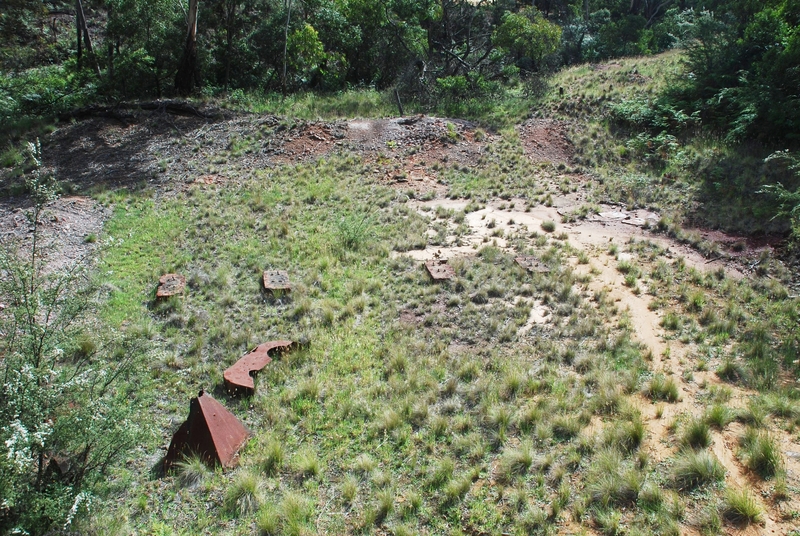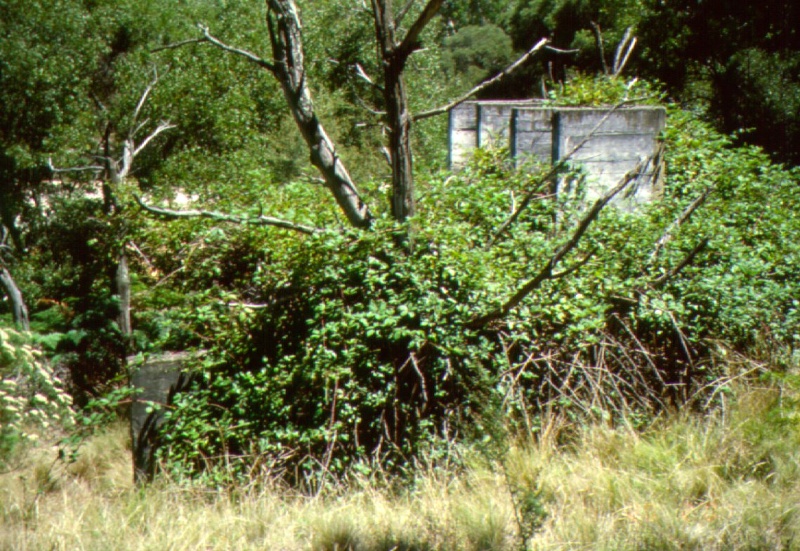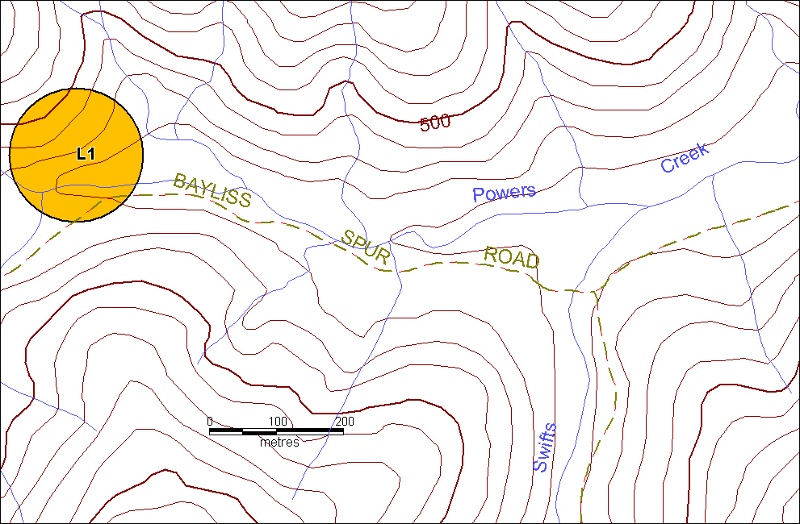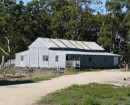CASSILIS GOLD MINING COMPANY TREATMENT WORKS
BAYLISS SPUR ROAD SWIFTS CREEK, EAST GIPPSLAND SHIRE
-
Add to tour
You must log in to do that.
-
Share
-
Shortlist place
You must log in to do that.
- Download report





Statement of Significance
The Cassilis GMC treatment works is in Power's Gully. It is the site of mining operations carried out from 1897 to 1916 and the elaborate plant and processes used to extract gold from heavily mineralised ore. Steam was first used to power the machinery at the site but a shortage - and consequent high cost - of firewood led to the company constructing a hydro-electric scheme. The power station operated from Victoria River. The scheme was completed in 1907, and by 1909 all steam engines had been replaced with electric motors. The significant visible components of the site include but are not limited to:
* Electricity substation.
* Loading ramp, which was fed by a tramway that runs around the spur to the mine workings.
* Battery foundations including mortar blocks and engine beds.
* Concrete vat piers and adjoining dump of treated battery sand.
* Brick and stone retaining wall.
* Brick and concrete-rendered vats and associated raised tailings pond.
* Riveted iron furnace lined with red fire bricks.
* Furnace bed.
* Remnant of large flue.
How is it significant?
The Cassilis GMC treatment works is of historical and scientific significance to the State of Victoria.
Why is it significant?
The Cassilis GMC treatment works is historically important as the largest and most successful mine to operate on the Cassilis field and due to its association with the construction of Victoria's first gold related hydro-electric scheme. The power station was located 27kms away, near the Victoria Falls on the Cobungra River.
The Cassilis GMC treatment works is scientifically important for the survival of a range of relics documenting the transition from steam-power to electric-power. No other historic gold mine in Victoria can match the site in documenting this transition or the underlying engineering ingenuity to achieve the switch from steam power to electric power. The site also is also significant due to its archaeological potential to yield relics associated with turn-of-the century gold mining technology.
-
-
CASSILIS GOLD MINING COMPANY TREATMENT WORKS - History
Contextual History:History of Place:
Cassilis Reef was discovered in 1890, the most westerly of seven reefs on a high ridge to the west of the Cassilis townships—it eventually became the main lode of the Cassilis GMC mine. Ore from the Cassilis Reef was heavily mineralised (containing no less than six minerals associated with the gold), and became increasingly so at depth, making gold retrieval virtually impossible using ordinary methods. In 1894, a small syndicate installed a five-head battery and small chlorination plant close to their tunnel. The chlorination plant proved inadequate and was replaced by a larger one in 1896, but still the ore proved too refractory.The Cassilis GMC was formed in 1897, with a capital of £12,000 in 24,000 shares. Extensive exploratory works were carried out—shafts sunk, tunnels driven—and the chlorination plant was further enlarged and improved. Test parcels of the ore (solid arsenical pyrites) yielded 5 oz to the ton. In 1898, the Cassilis Co. purchased the leases of the neighbouring North Cassilis Co. where an incredibly rich reef was soon after opened up—this lode was called the Ceresa. Additional treatment plant was installed in 1899: a Halley table, Berdan pan, a hand-operated reverberatory furnace. The Cassilis Co. had been having its ore crushed at the Warden battery, but in 1900 the company bought a 20-head battery from the Mt Hepburn Co. and installed it at the foot of the range, in Power’s Gully. During 1900-01, further plant was installed at the new site: a Jacques rock-breaker, two Edwards mechanical furnaces, and a new chlorination plant operating on the Munktell process using seven 11-ton leaching vats, seven precipitating vats, and six other accessory vats. A gravity tramline ran between mine and plant. In 1902, a new compressor, additional furnace, new engine, offices, and workshop were added. The large compressor delivered compressed air over two miles uphill to the mine, to power ten rock drills; its engine had a very heavy fly-wheel, to maintain an even speed to ensure constant air pressure at the mine. The company increased the capacity of its dam in Power’s Gully to 3 million gallons, and piped the water race from dam to battery. By 1903, the Cassilis Co.’s sprawling plant also included a dynamo to supply electric light, two large Berdan pans, amalgamating barrel, Kelly and Lewis vertical 150-hp engine, two large Cornish boilers (26 ft x 6 ft 6 in), two multi-tubular boilers (14 ft x 5 ft 6 in), and a cyanide plant of five 80-ton vats. Over 200 men were employed in the mine and treatment plant, with another hundred or so employed indirectly in carting, and supplying wood, charcoal, and lime.Additions to the Cassilis Co. plant continued in 1905, when 130 men were employed and 13,450 tons of ore were treated for a yield of 12,032 oz gold. The gravity tramline between mine and battery was replaced; a Hornsby oil-engine was installed for driving furnaces, conveyors, elevators, machines in shop, dynamo, and blowers (cheaper and more efficient than coke); and a foundry was erected, complete with testing-room and cupola furnace, enabling the company to ‘work up all the old iron and steel obtainable in the district, making a great saving in the manufacturing of numerous parts of the plant’. A telephone system was also installed. The company’s works were described as ‘quite a model plant’.The shortage—and consequent high cost—of firewood threatened to undermine the company’s ‘handsome profit’, so it was decided to construct a hydro-electric scheme, operating from the Victoria River, to power the mine and treatment plant. The scheme was completed in 1907, and by 1909 all old engines at the Cassilis Co.’s works were replaced with electric motors. But the holding dam for the hydro-electric works was never finished, and the company’s operations were crippled by power shortages during the drought years from 1910-14. In 1909, a new electrically-powered rotary air compressor was added to the Cassilis Co.’s plant, which was hailed as ‘one of the most extensive and complete in the State’. A new plant was installed in 1910 for treatment of the accumulated slimes by the vacuum filter process (replacing the chlorination plant), and the following year a tube mill was erected for re-treating residues from the roasting furnaces by the cyanide process. But output from the mine was falling—largely due to power shortages—and the ore from deeper levels was becoming increasingly difficult to treat. A grant from the Mines Department, enabled the company to prospect still deeper, in search of better ore—to no avail. Actual mining was confined to the Ceresa lode, which grew increasingly thin and poor in quality. By 1916, the Cassilis Co. was defeated and its mine and works closed.Between 1898-1916, the Cassilis Co.’s workings—by adit and internal shaft—reached a maximum depth of 1,300 ft, and 124,607 tons of ore were treated for a yield of 93,572 oz, valued at £383,645. The Cassilis Co. mine was the largest and most successful on the Cassilis field.From 1949, ore from the Cassilis mine was treated at Avery’s furnace plant at the Mt Hepburn/King Cassilis mine. Mining exploration of the former Cassilis Co. leases has taken place on several occasions since.CASSILIS GOLD MINING COMPANY TREATMENT WORKS - Assessment Against Criteria
Criterion
Criterion A
The historical importance, association with or relationship to Victoria's history of the place or object.
The Cassilis GMC treatment works is historically important as the largest and most successful mine to operate on the Cassilis field and due to its association with the construction of Victoria's first gold related hydro-electric scheme. The power station was located 27kms away, near the Victoria Falls on the Cobungra River.
Criterion B
The importance of a place or object in demonstrating rarity or uniqueness.
The Cassilis GMC treatment works is scientifically important for the survival of a range of relics documenting the transition from steam-power to electric-power. No other historic gold mine in Victoria can match the site in documenting this transition or the underlying engineering ingenuity to achieve the switch from steam power to electric power.
Criterion C
The place or object's potential to educate, illustrate or provide further scientific investigation in relation to Victoria's cultural heritage.
The Cassilis GMC treatment works is scientifically important for the survival of a range of relics documenting the transition from steam-power to electric-power. No other historic gold mine in Victoria can match the site in documenting this transition or the underlying engineering ingenuity to achieve the switch from steam power to electric power. The site also is also significant due to its archaeological potential to yield relics associated with turn-of-the century gold mining technology.
Criterion D
The importance of a place or object in exhibiting the principal characteristics or the representative nature of a place or object as part of a class or type of places or objects.
Criterion E
The importance of the place or object in exhibiting good design or aesthetic characteristics and/or in exhibiting a richness, diversity or unusual integration of features.
Criterion F
The importance of the place or object in demonstrating or being associated with scientific or technical innovations or achievements.
The Cassilis GMC treatment works is scientifically important for the survival of a range of relics documenting the transition from steam-power to electric-power. No other historic gold mine in Victoria can match the site in documenting this transition or the underlying engineering ingenuity to achieve the switch from steam power to electric power. The site also is also significant due to its archaeological potential to yield relics associated with turn-of-the century gold mining technology.
Criterion G
The importance of the place or object in demonstrating social or cultural associations.
Criterion H
Any other matter which the Council considers relevant to the determination of cultural heritage significance
technology.
CASSILIS GOLD MINING COMPANY TREATMENT WORKS - Permit Exemptions
General Exemptions:General exemptions apply to all places and objects included in the Victorian Heritage Register (VHR). General exemptions have been designed to allow everyday activities, maintenance and changes to your property, which don’t harm its cultural heritage significance, to proceed without the need to obtain approvals under the Heritage Act 2017.Places of worship: In some circumstances, you can alter a place of worship to accommodate religious practices without a permit, but you must notify the Executive Director of Heritage Victoria before you start the works or activities at least 20 business days before the works or activities are to commence.Subdivision/consolidation: Permit exemptions exist for some subdivisions and consolidations. If the subdivision or consolidation is in accordance with a planning permit granted under Part 4 of the Planning and Environment Act 1987 and the application for the planning permit was referred to the Executive Director of Heritage Victoria as a determining referral authority, a permit is not required.Specific exemptions may also apply to your registered place or object. If applicable, these are listed below. Specific exemptions are tailored to the conservation and management needs of an individual registered place or object and set out works and activities that are exempt from the requirements of a permit. Specific exemptions prevail if they conflict with general exemptions. Find out more about heritage permit exemptions here.Specific Exemptions:General Conditions:
1. All exempted alterations are to be planned and carried out in a manner which prevents damage to the fabric of the registered place or object.
2. Should it become apparent during further inspection or the carrying out of alterations that original or previously hidden or inaccessible details of the place or object are revealed which relate to the significance of the place or object, then the exemption covering such alteration shall cease and the Executive Director shall be notified as soon as possible.
3. If there is a conservation policy and plan approved by the Executive Director, all works shall be in accordance with it.
4. Nothing in this declaration prevents the Executive Director from amending or rescinding all or any of the permit exemptions.
Nothing in this declaration exempts owners or their agents from the responsibility to seek relevant planning or building permits from the responsible authority where applicable.
Exemptions of Permit
No permits are required for the following classes of works:
* Works required to leave abandoned adits or other earthworks in a safe condition.
* Undertaking of safety and access works to restrict vehicular access to the site and minimise removal of machinery and foot traffic near or on foundations.
* Repairs to the tailings pond.
Installation of information signage for interpretation and public risk purposes.
* On-site works confined to protect and stabilise buildings and structures.
* Repairs to buildings which replace like with like.
* Control of pest plants and animals.
* Preliminary mineral exploration involving geological, geophysical, and geochemical surveys.
Exemption Review
Permit exemptions will be reviewed in conjunction with a Conservation Management Plan when supplied by the owners and to the satisfaction of the Executive Director.CASSILIS GOLD MINING COMPANY TREATMENT WORKS - Permit Exemption Policy
Through the registration of the Cassilis GMC treatment works it is desired to retain the essential character of the place. The intent of the permit exemptions is to allow the normal day to day management of the site as a key component of the Cassilis Historic Reserve. The permit exemptions recognise the relative remoteness of the place and the potential for future mining to occur.
-
-
-
-
-
CASSILIS GOLD MINING COMPANY TREATMENT WORKS
 Victorian Heritage Register H1941
Victorian Heritage Register H1941 -
CASSILIS GOLD MINING COMPANY TREATMENT WORKS
 Victorian Heritage Inventory
Victorian Heritage Inventory
-
13 Flinders Street, Queenscliff
 Queenscliffe Borough
Queenscliffe Borough -
162 Nicholson Street
 Yarra City
Yarra City -
164 Nicholson Street
 Yarra City
Yarra City
-
-











